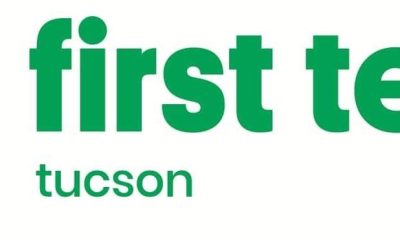Technology
Wearable Heart Monitoring Devices Market Size & Share
Wearable Heart Monitoring Devices Market Insights
Global Wearable Heart Monitoring Devices Market size was valued at USD 2.35 Billion in 2023 and is poised to grow from USD 2.60 Billion in 2024 to USD 6.10 Billion by 2032, growing at a CAGR of 11.3% in the forecast period (2025-2032).
The market is primarily driven by mounting cases of cardiovascular diseases, growing health consciousness, and the need to monitor patients in real-time. Wearable technology adoption for managing chronic conditions, especially across the elderly populations in North America and Asia-Pacific, is fueling global uptake.
Growth drivers include increasing investment in digital health infrastructure, increasing clinical adoption of connected devices, and consumers’ desire for non-invasive, real-time monitoring solutions. Furthermore, the availability of AI-fueled analytics and Bluetooth-based heart rate and ECG monitors boosts the degree of accuracy and ease of operation of devices. Important trends in the market are convergence to remote patient monitoring, miniaturization of medical-grade sensors, and technology giants and healthcare players entering into strategic partnerships. There also exists a need for wearables with in-built diagnostic and alarm functions. The market also has some important challenges in the form of data privacy issues, challenges in obtaining regulatory approvals, and the expense involved in high end medical grade wearables.
How is AI Transforming Innovation in Wearable Heart Monitoring Devices?
AI is transforming the wearable heart monitoring devices segment by enriching device functionality, streamlining diagnostics, and providing real time health information. Wearables are able to identify irregular heart rhythms, like atrial fibrillation, with medical grade accuracy using AI based algorithms bridging the chasm between consumer electronics and clinical diagnoses. Personalized tracking, adaptive notification, and foresight health trends are turning into mainstream capabilities in future generation devices.
- Google Health partnered with Fitbit in 2024 to launch AI powered ECG analysis and machine learning based heart rate monitoring for the early identification of cardiac abnormalities. Likewise, medical device companies such as Biobeat are leveraging AI for continuous, cuffless wearables capable of monitoring several vitals such as blood pressure and cardiac output.
AI also maximizes power efficiency, improves data interpretation, and facilitates effortless integration with telehealth platforms. These technologies are facilitating more precise, accessible, and proactive cardiac care—establishing AI as a fundamental product innovation driver in the wearable heart monitoring devices market
Market snapshot – (2025-2032)
Remote Patient Monitoring
Global Wearable Heart Monitoring Devices Market ($ Bn)
Country Share for North America Region (%)
To get more reports on the above market click here to
Buy The Report
Wearable Heart Monitoring Devices Market Segments Analysis
The wearable heart monitoring devices market is segmented into product type, device type, application, distribution channel, and region. Based on product type, the market is segmented into electric pulse-based products and optical technology-based product sources. Based on device type, the market is segmented into diagnostic and monitoring devices and therapeutic devices. Based on application, the market is segmented into sports & fitness, remote patient monitoring, and home services. Based on distribution channel, the market is segmented into online retail, pharmacies, consumer electronics stores, hospitals & clinics, and others. Based on region, the market is segmented into North America, Asia-Pacific, Europe, Latin America, and Middle East & Africa.
Which Application is Leading in Wearable Heart Monitoring Devices Market? Sports & fitness currently dominate the wearable heart monitoring devices market. This segment benefits from increasing health awareness, rising adoption of fitness-focused wearables, and a growing culture of proactive health monitoring. Devices such as smart earbuds and fitness trackers with built-in heart rate sensors are widely used by athletes, gym-goers, and health-conscious consumers. The demand is further driven by real-time monitoring features, ease of use, and integration with mobile health apps that help users track cardiovascular performance during workouts and daily activities.
As per the global wearable heart monitoring devices market forecast, remote patient monitoring represents the fastest-growing segment. The rise in chronic cardiovascular conditions, an aging population, and the need for post-hospitalization care at home are fueling demand. Technological advancements and increased use of telehealth services have further accelerated adoption in this segment.
Which Device Type Segment Accounts for Largest Share in Wearable Heart Monitoring Devices Industry?
According to global wearable heart monitoring devices market research, diagnostic and monitoring devices remain dominant due to their critical role in tracking cardiovascular health in real time. These devices, often integrated into wearables like earbuds and fitness trackers, are essential for collecting accurate physiological data such as heart rate, ECG, and blood oxygen levels. Their ability to provide continuous, non-invasive monitoring makes them highly valuable for fitness enthusiasts, patients with chronic heart conditions, and healthcare providers aiming for early detection and preventive care.
However, therapeutic devices are the fastest growing sub segment, driven by increasing demand for devices that not only monitor but also support treatment and recovery. These include wearables that assist in managing arrhythmias or aid in cardiac rehabilitation. With the growing emphasis on personalized healthcare, home based treatment, and integration of AI driven insights, therapeutic wearables are gaining traction as a future ready solution for managing heart health effectively outside of clinical settings.
Global Wearable Heart Monitoring Devices Market By Application (%)
To get detailed analysis on other segments,
Request For Free Sample Report
Wearable Heart Monitoring Devices Market Regional Insights
What Makes North America Dominating Region in Global Wearable Heart Monitoring Devices Market?
As per regional forecast, the wearable heart monitoring devices market in North America is highly developed and innovation led, driven by a robust digital health infrastructure, strong healthcare spending, and high awareness of cardiovascular conditions. The presence of key technology providers and early adoption of remote patient monitoring systems continue to shape market dynamics. Increasing chronic disease prevalence, particularly heart disease and hypertension, contributes to sustained demand for advanced wearable solutions.
Wearable Heart Monitoring Devices Market in the United States
The U.S. leads the global market in both consumption and innovation, backed by a large patient base, strong regulatory framework, and early integration of wearables into clinical practice. Strategic collaborations between healthcare systems and tech firms such as Apple, Fitbit, and Withings have fueled adoption. Reimbursement frameworks for remote monitoring and proactive wellness tracking further support market expansion.
Wearable Heart Monitoring Devices Market in Canada
Canada mirrors U.S. trends but at a more measured pace. The demand is largely driven by growing healthcare digitization and increased focus on elderly care. Remote and rural healthcare delivery challenges are addressed by wearable adoption, especially for cardiac event detection. Government support for digital health programs is also encouraging wider usage among patients with chronic conditions.
What Drives Growth in the Asia Pacific Wearable Heart Monitoring Devices Market?
Asia Pacific is one of the fastest growing regions in the wearable heart monitoring devices market due to rising lifestyle related illnesses, improving healthcare access, and a tech savvy population. Countries like China, India, and South Korea are witnessing growing demand for affordable and connected cardiac health devices. The expansion of mobile internet infrastructure and growing investment in telehealth platforms also fuel market development.
Wearable Heart Monitoring Devices Market in Japan
Japan’s market is advanced, yet aging population driven. Wearable heart monitoring solutions are increasingly integrated into elderly care systems and insurance-backed wellness programs. Trust in medical grade accuracy, product quality, and seamless health data tracking plays a critical role in consumer adoption.
Wearable Heart Monitoring Devices Market in South Korea
South Korea is rapidly integrating wearable technology into its smart healthcare ecosystem. With strong government backing for health tech innovation and widespread digital connectivity, the country is seeing rising usage of AI powered cardiac monitoring wearables. The local tech industry’s strength contributes to domestic innovation and competitive pricing.
How Does Europe Lead Ethical and Patient-Centric Innovation in Wearable Heart Monitoring Devices?
Europe is a mature and regulatory focused market emphasizing ethical data usage, patient safety, and sustainable healthcare. The region leads in integrating wearable technology into national health systems, supported by strong policies on digital health adoption and medical device compliance. Consumer confidence is driven by high data privacy standards and growing health consciousness.
Wearable Heart Monitoring Devices Market in Germany
Germany stands out for clinical grade wearable device adoption, particularly in hospitals and outpatient care. The country’s emphasis on health data protection, along with structured reimbursement systems for remote monitoring, supports market maturity. Innovation is driven by partnerships between medical tech firms and university hospitals.
Wearable Heart Monitoring Devices Market in the United Kingdom
The UK market is defined by high public health awareness and NHS-backed digital health programs. Wearables are widely used for early diagnosis and self-care management of cardiovascular diseases. Post-Brexit regulatory alignment and innovation grants are promoting local development and wider patient access to smart heart monitoring tools.
Wearable Heart Monitoring Devices Market in Italy
Italy is witnessing growing adoption of wearable heart monitors, especially among elderly populations and in preventive cardiology. Increased focus on home based health tracking and chronic disease management is driving demand. Urban centers show higher penetration, while rural expansion is supported by telehealth services and regional healthcare initiatives.
Global Wearable Heart Monitoring Devices Market By Geography
To know more about the market opportunities by region and country, click here to
Buy The Complete Report
Wearable Heart Monitoring Devices Market Dynamics
Wearable Heart Monitoring Devices Market Drivers
Increasing Incidence of Cardiovascular Diseases and the Role of Early Diagnosis
- By 2024, the global burden of cardiovascular disorders (CVDs) has only have increased and has been countered by consumers and the healthcare system by placing more importance on early diagnosis and continuous monitoring. Portable heart monitors such as smartwatches, ECG patches, and biosensors are easy-to-wear devices that are less painful and give real-time monitoring of heart activity, enabling early identification of arrhythmia, hypertension, and other cardiac diseases. Their ease of use, non-invasiveness, and flexibility to support the requirements of elderly and chronic heart patients drive demand in clinical and consumer segments.
Integration with Digital Health Ecosystems and Remote Monitoring
- Increased adoption of telehealth and remote monitoring of patients is fueling the demand for wearable heart monitoring products, especially in post-acute care and chronic disease management. Up to 2024, the evolution of Bluetooth, AI, and cloud-based health platforms will facilitate effortless transfer of information from wearables to clinicians. It not only reduces patient interaction but also reduces hospital readmissions and healthcare costs. The trend is increasing rapidly in developed markets and gradually building in developing markets, and wearables increasingly become a component of connected care delivery systems.
Wearable Heart Monitoring Devices Market Restraints
Privacy and Regulatory Compliance for Health Data
- Since there is higher adoption of wearables in 2024, concerns for privacy related to individual health information have grown. Sensitive biometric information like ECG and heart rate are collected by wearable heart rate monitors and are mostly stored in the cloud infrastructure or third party apps. The regulatory regulations like HIPAA in America and GDPR in Europe require intense processing of data and user consent procedures. Compliance is costly and makes it more difficult to develop products, especially for foreign market entry by companies. Misuse and health information violations result in customer mistrust and adoption lag.
Issues of Cost and Availability in Emerging Markets
- Despite the developments in technology, cost continues to be the greatest barrier, as it is, particularly in low- and middle-income economies. High technology capable, clinical grade heart monitoring wearables are typically beyond the reach of mass consumers, excluding widespread adoption. Until 2024, limited insurance coverage and lack of digital health infrastructure among rural and underserved communities continue to pose barriers. These differences discourage worldwide applicability of wearable solutions and benefit technologically advanced city-based populations at the expense of the vast majority of potential end users being underserved.
Request Free Customization
of this report to help us to meet your business objectives.
Wearable Heart Monitoring Devices Market Competitive Landscape
The competitive landscape of Wearable Heart Monitoring Devices Market are driven by a group of global tech companies, med tech giants, and niche health startups racing for innovation supremacy. Apple, Google owned Fitbit, and Garmin deploy networked ecosystems, brand power, and advanced R&D capabilities to pursue consumer grade monitoring segments. These offerings are multimodal in nature, syncing heart monitoring with fitness, sleep, and wellness features placing them as lifestyle health products. Healthcare device companies like Philips, irhythm, and biobeat innovate with clinical precision, FDA cleared diagnostics, and easy plug and play integration into hospitals and telemedicine infrastructures. They’re masters of prolonged monitoring, arrhythmia detection, and far from clinic patient care and are priceless partners for global healthcare systems. Strategic partnerships with cardiology centers and payers are driving product growth into home care and outpatient settings.
In 2024, Medtronic augmented its family of wearable ECG patches with AI capability through partnerships with remote care platforms in Europe and the U.S., expanding its clinical footprint and engaging patients more through cloud-based analytics and real-time alerts. Established startups are transforming the industry with wearable biosensors and analytics driven by artificial intelligence that provide affordable, real-time surveillance of cardiovascular health. They prioritize usability, simplicity, and EMR to health app compatibility. Such solutions appeal to consumers and clinicians eager to have simple and scalable monitoring.
- Cardiomo (U.S., 2016) is providing a small real-time biosensor monitoring ECG, breathing, and heart rate variability. It is worthy because it continuously monitors weak patients with health alerts using AI, allowing for early treatment and fewer readmissions to the hospital. It is light, unobtrusive, and can be used with mobile health apps, hence finding its best use in home care settings.
- Aktiia (Switzerland, started in 2018) created a wrist device continuously monitoring cardiovascular readings and blood pressure using optical sensors and custom algorithms. It is centered on chronic blood pressure management with medical-grade precision without cuffing. The emphasis is on convenience, clinical accuracy, and hassle-free data transfer between patients and clinicians—marking itself as a chronic heart condition management disruptor. These innovations are shaping a dynamic environment in which innovation, connectivity, and precision are propelling the next generation of wearable heart monitoring technology.
Top Player’s Company Profiles
- Samsung Electronics Co., Ltd.
- iRhythm Technologies, Inc.
- Withings (formerly Nokia Health)
- Biobeat Technologies Ltd.
Recent Developments in Wearable Heart Monitoring Devices Market
• In March 2024, Biobeat Technologies Ltd. launched its next generation wearable biosensor capable of measuring cardiac output and stroke volume continuously without invasive procedures. This upgrade enhances early detection of cardiovascular complications in high risk patients and is being piloted in several European hospitals under remote monitoring programs.
• In April 2024, Philips announced a strategic collaboration with U.S. based AI startup heart logic AI to integrate machine learning-based arrhythmia prediction models into its wearable patch ECG systems. The partnership aims to advance real-time diagnostic accuracy and improve long-term cardiac care for both home and clinical settings.
• In May 2024, Apple Inc. unveiled a new health focused Apple Watch feature, Smart heart+, which uses AI to identify subtle heart rate fluctuations indicative of early atrial fibrillation. Approved by the U.S. FDA, the update reinforces Apple’s expansion into regulated health monitoring and is positioned as a preventive care tool for aging users and those with chronic cardiac conditions.
Wearable Heart Monitoring Devices Key Market Trends
• AI-Driven Personalized Monitoring Is Picking Up Pace: Wearable heart monitors in 2024 are more and more augmented with AI driven functionalities that allow real time, customized cardiac information. The technologies assist in the early identification of arrhythmias and facilitate user specific health alerts based on patterns of user data, greatly enhancing patient activation and preventive care.
• Telehealth Platform Integration Is Fuelling Adoption: As telemedicine expands all over the world, wearable tech is proving to be the hub of remote cardiac monitoring. During 2024, top manufacturers have ranked foremost in terms of unproblematic integration with telehealth and EHR systems, so that clinicians can picture patients’ cardiovascular well being in real time and alter treatment in real time especially in geriatric and high risk patients.
Wearable Heart Monitoring Devices Market SkyQuest Analysis
SkyQuest’s ABIRAW (Advanced Business Intelligence, Research & Analysis Wing) is our Business Information Services team that Collects, Collates, Correlates, and Analyses the Data collected by means of Primary Exploratory Research backed by robust Secondary Desk research.
As per SkyQuest analysis, Key drivers of market growth include rapid advancements in sensor technology and artificial intelligence, which enhance the accuracy, responsiveness, and usability of heart monitoring devices for both clinical and personal use. The main market growth driver is the rising global prevalence of cardiovascular diseases, fueling demand for continuous, non invasive monitoring tools to detect early symptoms and manage chronic conditions efficiently. The widespread shift toward home based and remote cardiac care, supported by growing healthcare digitization, continues to accelerate wearable device adoption. However, the market faces a significant restraint in terms of regulatory complexity and health data privacy concerns. As these devices collect sensitive biometric information, they must comply with stringent frameworks like HIPAA and GDPR, which can slow product development and international deployment. Ensuring data security and ethical handling remains a top challenge for manufacturers. Geographically, Asia Pacific is emerging as a major growth hub due to increasing healthcare investments, widespread smartphone penetration, and greater public awareness of preventive health. Countries such as China, India, and Japan are actively promoting digital health infrastructure and wearables for remote patient monitoring, contributing to rapid market expansion across urban and rural populations.
| Report Metric | Details |
|---|---|
| Market size value in 2023 | USD 2.35 Billion |
| Market size value in 2032 | USD 6.10 Billion |
| Growth Rate | 11.3% |
| Base year | 2024 |
| Forecast period | (2025-2032) |
| Forecast Unit (Value) | USD Billion |
| Segments covered |
|
| Regions covered | North America (US, Canada), Europe (Germany, France, United Kingdom, Italy, Spain, Rest of Europe), Asia Pacific (China, India, Japan, Rest of Asia-Pacific), Latin America (Brazil, Rest of Latin America), Middle East & Africa (South Africa, GCC Countries, Rest of MEA) |
| Companies covered |
|
| Customization scope |
Free report customization with purchase. Customization includes:-
|
To get a free trial access to our platform which is a one stop solution for all your data requirements
for quicker decision making. This platform allows you to compare markets, competitors who are prominent
in the market, and mega trends that are influencing the dynamics in the market. Also, get access to
detailed SkyQuest exclusive matrix.
Buy The Complete Report
to read the analyzed strategies adopted by the top vendors either to retain or gain market share
Technology
Gaming PC Market to Expand at 7.29% CAGR Through 2035 Driven


Gaming PC Market is witnessing rapid expansion as gaming evolves into one of the largest and most impactful segments of the digital entertainment industry. According to Market Research Future (MRFR), the Gaming PC Market Size was valued at USD 46.98 billion in 2024. The Gaming PC industry is projected to grow from USD 50.41 billion in 2025 to USD 101.9 billion by 2035, exhibiting a strong and consistent compound annual growth rate (CAGR) of 7.29% during the forecast period from 2025 to 2035.
The rise of high-performance gaming hardware, increasing popularity of competitive gaming, and strong global demand for immersive entertainment experiences are major factors supporting market growth. Gaming PCs are now central to professional eSports, casual gaming, and content creation, making the industry a key driver of technological innovation.
Market Drivers Fueling the Growth of the Gaming PC Market
One of the primary drivers accelerating the Gaming PC Market is the explosive rise of the global eSports ecosystem. Millions of players participate in online competitions, and large-scale tournaments attract global audiences. Professional gamers demand high-performance PCs capable of delivering maximum responsiveness, minimal lag, and high frame rates, directly boosting the need for advanced gaming systems.
Another critical driver is rapid GPU and CPU innovation. Leading hardware manufacturers continue to develop powerful processors and graphics cards equipped with next-generation capabilities such as ray tracing, AI-enhanced rendering, and ultra-fast clock speeds. These innovations significantly elevate gaming experiences and motivate both casual gamers and professionals to upgrade their systems.
The increasing popularity of open-world, high-resolution, and graphically demanding games is further boosting Gaming PC adoption. Modern titles require advanced hardware to support realistic visuals and immersive gameplay, pushing consumers toward high-end gaming PCs.
The rise of game streaming and content creation is also contributing to market expansion. Platforms such as Twitch, YouTube Gaming, and Facebook Gaming are encouraging gamers to produce high-quality content. This requires powerful systems that support streaming, recording, editing, and gameplay simultaneously.
Customization and personalization trends are shaping consumer behavior as well. Gamers increasingly prefer custom-built PCs with RGB lighting, advanced cooling solutions, and modular components. This trend is creating new opportunities for manufacturers, retailers, and PC assembly services globally.
Get An Exclusive Sample of the Research Report at – https://www.marketresearchfuture.com/sample_request/26477
Key Market Trends Shaping the Gaming PC Market
The Gaming PC Market is being reshaped by a number of powerful trends. One of the most significant is the integration of artificial intelligence into gaming hardware. AI-driven optimization tools help maximize performance, regulate cooling, enhance frame rates, and adjust settings in real time.
Another major trend is the growing dominance of high-performance gaming laptops. With advancements in thermal engineering and GPU performance, gaming laptops now offer nearly desktop-level power. This trend supports gamers who value flexibility and portability without sacrificing performance.
High-refresh-rate monitors are becoming standard among gamers. Demand for 144Hz, 240Hz, and even 360Hz displays is rising as gamers seek smoother animation and higher responsiveness, driving the need for PCs capable of supporting these advanced displays.
Liquid cooling systems are also gaining popularity. As gaming hardware becomes more powerful, maintaining safe temperatures is essential. Gamers increasingly adopt closed-loop and custom-loop liquid cooling systems to ensure long-term stability and performance.
Sustainable and energy-efficient gaming solutions are emerging as a new trend. Manufacturers are focusing on recyclable components, environmentally friendly production processes, and energy-efficient power supplies. This aligns with global sustainability awareness and appeals to environmentally conscious gamers.
Buy Now Immediate Delivery Available at – https://www.marketresearchfuture.com/checkout?currency=one_user-USD&report_id=26477
Regional Analysis of the Gaming PC Market
North America currently dominates the Gaming PC Market, supported by a large base of professional gamers, robust digital infrastructure, and widespread adoption of high-performance gaming systems. The United States remains a global leader in gaming hardware development and eSports investment.
Europe holds a significant share of the market as well. Countries such as Germany, France, and the United Kingdom have strong gaming cultures, extensive PC gaming communities, and widespread interest in competitive gaming. Government recognition of eSports as an official sport in certain regions has further strengthened market demand.
The Asia-Pacific region is poised for the highest growth rate during the forecast period. Nations such as China, South Korea, Japan, and India are expanding rapidly in the gaming ecosystem. China leads the region with millions of active gamers and strong investment in gaming arenas, esports stadiums, and internet cafés. South Korea remains a global pioneer in professional gaming and eSports.
Latin America is also witnessing rising Gaming PC adoption. Countries such as Brazil, Mexico, and Argentina are experiencing increasing interest in professional gaming and streaming, supported by improved internet connectivity and the establishment of local gaming events.
In the Middle East and Africa, gaming is expanding as younger populations adopt digital entertainment. Countries such as the UAE and Saudi Arabia are investing heavily in eSports infrastructure, creating new opportunities for Gaming PC manufacturers.
Challenges and Constraints in the Gaming PC Market
Despite strong growth potential, the Gaming PC Market faces several challenges. One major constraint is the high cost of components such as GPUs, CPUs, and high-performance RAM. Price fluctuations and supply shortages often discourage consumers from purchasing or upgrading gaming PCs.
Another challenge is the global supply chain volatility that affects semiconductor manufacturing. Limited chip availability during periods of high demand can delay product releases and reduce availability in key markets.
Energy consumption and heat generation are significant constraints as well. High-performance systems require efficient cooling solutions, and inadequate thermal management can impact performance and hardware longevity.
The rapid pace of technological change can also be a barrier for consumers. Frequent hardware upgrades may be required to support the latest games, making ownership costly for budget-conscious gamers.
Cybersecurity concerns surrounding online gaming and digital downloads pose additional challenges. Gamers are at risk of malware attacks, hacking, and data breaches, making security software an essential component of gaming setups.
Opportunities Driving Future Growth of the Gaming PC Market
Despite challenges, the Gaming PC Market offers vast opportunities. The expansion of VR and AR gaming is creating strong demand for powerful gaming PCs capable of supporting immersive experiences. As VR titles grow more sophisticated, hardware requirements will increase, benefiting the Gaming PC industry.
Cloud-connected gaming PCs present another major opportunity. Hybrid gaming systems that combine traditional hardware with cloud-based rendering can enhance performance and enable cost-effective upgrades.
The rise of gaming-focused social platforms is opening opportunities for PC manufacturers and accessories companies. Integrated ecosystems that support gaming, streaming, editing, and social interaction are becoming increasingly popular.
Emerging markets present strong potential for future expansion. Countries in Southeast Asia, the Middle East, Eastern Europe, and Africa are witnessing fast-growing gaming communities and rising disposable incomes, driving demand for affordable gaming PCs.
The growing support for STEM education and gaming-related careers such as game development, animation, and broadcasting is also fueling market demand. Students and professionals require powerful machines that deliver both gaming and productivity performance.
Explore the In-Depth Report Overview – https://www.marketresearchfuture.com/reports/gaming-pc-market-26477
The Gaming PC Market is set for robust expansion as global demand for high-performance gaming systems continues to rise. With a projected CAGR of 7.29% through 2035, the industry will benefit from technological innovation, eSports growth, immersive gaming trends, and rising participation in global gaming communities. Gaming PCs are becoming more advanced, more customizable, and more accessible, making them essential tools for gamers, streamers, content creators, and digital professionals alike. As hardware manufacturers push boundaries and gaming culture expands worldwide, the Gaming PC Market will remain a powerful driver of digital entertainment and global technological development.
About Market Research Future:
At Market Research Future (MRFR), we enable our customers to unravel the complexity of various industries through our Cooked Research Report (CRR), Half-Cooked Research Reports (HCRR), Raw Research Reports (3R), Continuous-Feed Research (CFR), and Market Research & Consulting Services.
MRFR team have supreme objective to provide the optimum quality market research and intelligence services to our clients. Our market research studies by products, services, technologies, applications, end users, and market players for global, regional, and country level market segments, enable our clients to see more, know more, and do more, which help to answer all their most important questions.
Contact Us:
Market Research Future (Part of Wantstats Research and Media Private Limited)
99 Hudson Street, 5Th Floor
New York, NY 10013
United States of America
+1 628 258 0071 (US)
+44 2035 002 764 (UK)
Email: sales@marketresearchfuture.com
Website: https://www.marketresearchfuture.com
This release was published on openPR.
Technology
Revived Retro Handheld Games : Ayaneo Pocket Play

A mobile-class processor powers the unit and includes 16 GB of RAM and up to 1 TB of internal storage. A dual-fan assembly and heat pipe design provide cooling. Battery capacity supports several hours of sustained gameplay, depending on the title and settings. Wireless connectivity includes Wi-Fi 6 and Bluetooth 5.2.
Image Credit: AYANEO
Technology
SA Gaming confirms presence at ICE Barcelona 2026 with showcase of premium live casino solutions

ICE Barcelona, which gathers more than 600 solution providers and an estimated 55,000 global gaming professionals, continues to serve as a critical hub for business expansion, technological innovation and international networking.
For SA Gaming, the event represents a prime opportunity to demonstrate its advances in live casino technology while strengthening its commercial footprint across Europe and beyond.
“We are excited to join ICE Barcelona 2026 and share our newest developments directly with operators and industry partners,” the company said. “The event provides the perfect setting to present our innovations and build strategic partnerships that can fuel long-term growth.”
Visitors to Stand 1E50 will have the opportunity to experience firsthand SA Gaming’s latest platform updates, table game enhancements and interactive live dealer features designed to increase player engagement and operational efficiency.
Event Details
Dates: January 19–21, 2026
Location: Fira Barcelona Gran Via, Barcelona, Spain
Stand: 1E50
SA Gaming is also inviting operators, partners and prospective clients to schedule dedicated meetings with its team during the three-day event. Those interested can secure an appointment through the company’s booking link.
As the countdown to ICE Barcelona 2026 begins, SA Gaming positions itself among the top exhibitors preparing to shape the future of live casino technology on one of the industry’s most prominent stages.
SA Gaming
SA Gaming is a leading Live Game Solution provider offering premium online entertainment for more than 15 years. Making use of state-of-the-art technology, it offers a full spectrum of Live Games including Baccarat, Roulette, Blackjack and many more.
The company has a Supplier License and an RGS Approval from the Ministry of Foreign Trade and Tourism of Peru (MINCETUR) and a B2B License from the Curacao Gaming Control Board (GCB). Every product is developed by professionals with diligence, and comes with trustworthy support services.
SA Gaming’s products are very popular among players around the world. Winner of the “Best Live Casino Provider” at SiGMA Asia Awards, “Best Live Dealer Solution” at Asia Gaming Awards, “Developer of the Year” at SPiCE Awards, and many other awards, SA Gaming’s efforts and achievements are well recognized in the industry.
Fonte: GMB
Technology
Tencent Cloud Announces Strategic Partnership with MADFINGER Games

Our website uses cookies, as almost all websites do, to help provide you with the best experience we can.
Cookies are small text files that are placed on your computer or mobile phone when you browse websites.
Our cookies help us:
– Make our website work as you’d expect
– Remember your settings during and between visits
– Offer you free services/content (thanks to advertising)
– Improve the speed/security of the site
– Allow you to share pages with social networks like Facebook
– Continuously improve our website for you
– Make our marketing more efficient (ultimately helping us to offer the service we do at the price we do)
We do not use cookies to:
– Collect any personally identifiable information (without your express permission)
– Collect any sensitive information (without your express permission)
– Pass personally identifiable data to third parties
– Pay sales commissions
Technology
How India’s Growing Tech Sector Is Powering the Global Online Gaming Boom

India’s tech revolution is transforming the types of industries in which a country known for its call centers and record numbers of internet users is vying for global influence. Thanks to cutting-edge software development, sophisticated mobile infrastructure, and a thriving startup culture, today our most compelling online gaming experiences are powered from India. Fast mobile networks and innovations on platforms such as baccarat online casino, with game-changing gameplay options that allow players to interact in real time, are driving the rise of India-based tech talent behind a digital entertainment boom capturing audiences around the globe.
A Digital Powerhouse Rising
India’s tech sector is growing at such a breakneck pace that it is contributing billions of dollars to the digital economy. As a result, because of its 500 million-plus internet users and one of the world’s largest pool of developers, the country has become an incubator for online gaming innovation. Leading gaming firms and casino software developers are joining hands with Indian companies to create seamless interfaces, safe payment modes, and rich game-play experiences.
This growth is driven primarily by cloud, AI and blockchain technology. Indians now have their own developers to thank for such massive functioning systems that accommodate millions of live dealer players, participating in esports, or making real-time bets without any significant lag, as well as significantly reinforced data security.
Mobile-First Gaming Revolution
One of India’s greatest giveaways is its mobile gaming. With cheap smartphones and data plans that are now nearly free, India has minted a whole new generation of gamers. This focus on mobile has led global platforms to tailor their gaming solutions for the small screen, not at the expense of quality.
From games of skill to real-money software and everything in between, Indian devs have become the driving force behind cross-device gaming. Snap features, easy to use interfaces, and one-touch payment capabilities are defining new benchmarks in the industry.
Tech Innovation Meets Entertainment
India’s skills when it comes to fintech and AI have also changed the way that players interact with digital casinos and gaming apps. AI-based personalization facilitates game recommendations per user preferences and sophisticated analytics for fairness and balance.
Meanwhile, strong fintech systems are keeping the money moving quickly and smoothly across borders. Thanks to India building a next-gen payment API, now instant deposits & withdrawals are enabled in gaming platform across the world.
Cultural Impact and Global Reach
The world gaming market is increasingly turning its attention to India, not just for tech innovation, but also for creativity and storytelling. Truly Indian games based upon the mythology, culture, and adventurous themes are now getting recognition all over the world, providing new stories and next-level experience.
Indian studios are partnering with international entertainment giants to create new hybrid gaming formats that combine traditional gameplay with live interaction, streaming and social. It is this mixture that has made India a key player in the international gaming space.
The Future of Global Gaming
With this heady mix of creativity, tech muscle, and entrepreneurial vigour, India’s tech sector is expected to drive the next wave of digital entertainment. From A.I.-enhanced platforms to live casino rooms, the country’s creative products are defining how millions play — and communicate.
With rapidly evolving mobile access and cloud infrastructure, India’s impact on global gaming will only solidify, creating one of the key driving forces in the world behind online gaming explosion.
Technology
Wearable Gaming Accessories Market Growth Outlook


New Jersey, US State: “The global Wearable Gaming Accessories market in the Consumer Goods and Retail category is projected to reach USD 12.8 billion by 2031, growing at a CAGR of 10.5% from 2025 to 2031. With rising industrial adoption and continuous innovation in Consumer Goods and Retail applications, the market is estimated to hit USD 5.2 billion in 2024, highlighting strong growth potential throughout the forecast period.”
Wearable Gaming Accessories Market Size & Forecast 2031
The wearable gaming accessories market is projected to grow steadily through 2031, driven by increasing demand for immersive and interactive gaming experiences. Devices such as haptic suits, smart gloves, motion sensors, and VR headsets are gaining popularity among gamers for their ability to provide real-time feedback, enhanced control, and full-body engagement. Manufacturers are focusing on ergonomic designs, lightweight materials, and wireless connectivity to improve comfort and usability. The rise of eSports, VR gaming, and mobile gaming platforms is further supporting market expansion, while growing interest in fitness-integrated gaming is creating new application opportunities. Expanding online retail channels and gaming communities are increasing product accessibility and awareness among diverse consumer segments.
By 2031, the wearable gaming accessories market is expected to achieve significant valuation as companies introduce innovations in haptic feedback, motion tracking, and AI-driven interactions. Integration with augmented reality (AR) and virtual reality (VR) platforms is driving adoption of advanced accessories that enhance realism and gameplay immersion. Rising disposable incomes, coupled with growing interest in premium gaming experiences, are encouraging high-end purchases. Continuous product development focusing on personalization, durability, and multi-functionality is fostering repeat purchases and brand loyalty. As technology evolves and gamers increasingly seek next-level interactive experiences, the wearable gaming accessories market is poised for sustained long-term growth.
Key Players in the Wearable Gaming Accessories Market
Sony Corporation
Microsoft Corporation
Oculus VR (Meta Platforms Inc.)
Valve Corporation
Nintendo Co. Ltd.
Razer Inc.
Logitech International S.A.
HTC Corporation
Samsung Electronics Co. Ltd.
VIVE (HTC)
Corsair Gaming Inc.
For Further Detail, Download the Sample PDF with Complete TOC, Tables, Figures, Charts, And More @ https://www.marketresearchintellect.com/download-sample/?rid=413001&utm_source=OpenprOct&utm_medium=047
Factors Supporting Growth of Wearable Gaming Accessories Market in the Future:
1.Technological Advancements and Innovation:
The continuous evolution of technology is playing a vital role in driving the Wearable Gaming Accessories market forward. Cutting-edge innovations are improving product functionality, enhancing performance, and reducing costs, making these solutions more accessible to a broader range of industries. Emerging technologies such as AI, IoT, advanced analytics, and automation are also enabling smarter and more efficient use cases, further expanding the scope of the market. These advancements are not only upgrading existing systems but are also creating entirely new application opportunities that will support long-term market expansion.
2. Expanding Applications Across End-Use Sectors:
The increasing integration of Wearable Gaming Accessories solutions across diverse industries such as automotive, healthcare, consumer electronics, telecom, and industrial manufacturing is significantly boosting market demand. Each sector brings unique requirements, pushing companies to diversify their offerings and customize solutions. This cross-industry relevance ensures consistent demand growth, while rising digitalization and adoption of smart technologies amplify the market potential across both developed and developing regions.
3. Favorable Government Policies and Infrastructure Push:
Supportive initiatives by governments around the world, including funding programs, tax incentives, and policy frameworks, are providing a strong foundation for market development. Efforts to strengthen digital infrastructure, promote energy efficiency, and drive sustainable development are fueling demand for advanced Wearable Gaming Accessories technologies. Moreover, public-private partnerships and national transformation agendas such as smart cities and Industry 4.0 are creating favorable conditions for rapid market expansion, especially in emerging economies
4. Increased Investment and Focus on Research & Development:
The Wearable Gaming Accessories market is experiencing a surge in investment from both private and public entities, driven by the urgency to innovate and stay competitive. Companies are dedicating substantial resources to research and development to create next-generation products with higher efficiency, scalability, and environmental sustainability. Venture capital funding, mergers, acquisitions, and collaborations are also contributing to a dynamic ecosystem that fosters experimentation and accelerates commercialization of novel solutions, ensuring sustained market growth in the future.
To avail a discount on the purchase of this report visit the link @ https://www.marketresearchintellect.com/ask-for-discount/?rid=413001&utm_source=OpenprOct&utm_medium=047
Key Segments Covered in Our Report: Wearable Gaming Accessories Industry
Wearable Gaming Accessories Market by Head-mounted Displays
VR Headsets
AR Glasses
Smart Glasses
Wearable Gaming Accessories Market by Wearable Controllers
Motion Controllers
Wearable Keypads
Haptic Feedback Devices
Wearable Gaming Accessories Market by Wearable Sensors
Fitness Trackers
Heart Rate Monitors
Motion Sensors
Wearable Gaming Accessories Market by Wearable Accessories
Gaming Gloves
Vests
Footwear
Wearable Gaming Accessories Market by Audio Wearables
Gaming Headsets
Bone Conduction Headphones
Earbuds
The Application segment showcases the industries and sectors that use Wearable Gaming Accessories products for example Wearable Gaming Accessories targeting healthcare and automotive industries etc. It also provides a perspective of the market rate of acceptance, usage of the products, and new applications that are paving the way for the future of the market.
Global Wearable Gaming Accessories Market Regional Analysis
The Global Wearable Gaming Accessories Market is examined in dimensions of regions, wherein each region has its own market growth, trends as well as dynamics. This section highlights on the detailed market performance, major shifts, and trends and underlying factors explaining growth in different places around the world.
North America: North America accounts for a large share of the Wearable Gaming Accessories market which is a result of the developed technology, intense consumer market, and huge investments in the Wearable Gaming Accessories industry. To add, the U.S. market also plays a crucial role as this economy is more concerned with innovation and was also one of the first to implement Wearable Gaming Accessories products in its Wearable Gaming Accessories sectors. The region is expected to see a gradual rise till 2031 and this is because of its reinforced infrastructure and existing regulation mechanisms.
Europe: Global has the fastest growing Wearable Gaming Accessories market and is oriented around environmental protection, renewed efforts and environmental awareness. The market is dominated by countries like Germany, the UK, and France that have improved their technologies and have a strong industrial structure. Increased request for green solutions along with regulatory efforts are increasing demand in the market’s key areas such as Wearable Gaming Accessories sectors.
Asia-Pacific: The growth potential in the Wearable Gaming Accessories market is expected to be maximum for Asia-Pacific region. Increased maturation, urban migration as well as expanding middle class in China, India, and Japan and other developing economies are great constituents of market growth. Further, there is an increasing contribution to investments in the Wearable Gaming Accessories sector which is increasing the demand for Wearable Gaming Accessories regions-supplying throughout the area.
Rest of the World: Countries and areas like Latin America, Middle East & Africa have also been showing moderate Wearable Gaming Accessories market growth. Although still developing, these markets are fueled by a fast increasing infrastructure, expending industrial activities and growing consumer demand for Wearable Gaming Accessories goods. These regions pose great opportunities for the market players to tap into other sources of growth.
Frequently Asked Questions (FAQ) – Wearable Gaming Accessories Market
Q1: What is the anticipated growth rate of the Global Wearable Gaming Accessories Market?
A1: With a growth rate of CAGR of 10.5%, the Global Wearable Gaming Accessories Market is anticipated to reach USD 12.8 billion by 2031. Industrial demand and innovation will lead it to reach USD 5.2 billion by 2024.
Q2: Which regions provide the highest growth opportunities for the Wearable Gaming Accessories Market?
A2: Asia-Pacific is likely to provide the highest growth prospects based on speedy industrialization and infrastructure growth, followed by robust markets in Europe and North America.
Q3: Which are the primary drivers of market growth?
A3: The primary drivers are technology innovation, growing industrial applications, heightened government initiatives, and expanding use of Wearable Gaming Accessories solutions in different industries.
Q4: What are the challenges faced by the Wearable Gaming Accessories Market?
A4: The challenges are tight regulatory systems, high upfront capital expenditures, fragmentation of the market in the emerging markets, and geopolitical risks in some regions.
Q5: Which are the major players in the Global Wearable Gaming Accessories Market?
A5: The market has a number of leading players with a focus on innovation, strategic alliances, and global expansion.
Q6: How does innovation influence the Wearable Gaming Accessories Market?
A6: Market growth is driven by innovation, which enhances product efficiency, lowers costs, and facilitates new applications, making the overall market potential broader.
Q7: Which industries utilize Wearable Gaming Accessories products mostly?
A7: Major industries include manufacturing, automotive, energy, electronics, and infrastructure, among others, where Wearable Gaming Accessories solutions deliver operational efficiency and sustainability.
Q8: How is the market anticipated to change after 2031?
A8: Although projections beyond 2031 are uncertain, continued technological advancement and increasing industrial demand are expected to continue supporting long-run growth patterns.
For More Information or Inquiries, Visit @ https://www.marketresearchintellect.com/product/global-wearable-gaming-accessories-market-size-and-forecast/?utm_source=OpenprOct&utm_medium=047
About Us: Market Research Intellect
Market Research Intellect is widely recognized as one of the leading global market research companies, with strong capabilities in data interpretation as well as business intelligence. Our objective is to support businesses in various sectors with relevant insight of their markets enabling them to make sound choices, expand and remain competitive in the changing business environment.
Backed with an expert team of analysts, we carry out detailed market assessment and market potential forecasts for a wide range of fields including but not limited to technology, healthcare, automotive, energy, and many more. This also includes market definition, development of market forecasts, trend analysis, analysis of competitive environment and core comprehensive market research that is necessary for the client.
As a focus, we always strive to provide accurate and reliable data, or if need be, tailored solutions to the problems and possibilities present in the market worldwide. With the use of novel research approaches, we are able to provide intelligence that will help organizations in the ever dynamic business world.
Should you have any queries, please contact us as follows:
Mr. Edwyne Fernandes
Market Research Intellect
APAC: +61 485 860 968
EU: +44 788 886 6344
Us: +1 743 222 5439
This release was published on openPR.
-

 Rec Sports3 weeks ago
Rec Sports3 weeks agoFirst Tee Winter Registration is open
-

 Rec Sports2 weeks ago
Rec Sports2 weeks agoFargo girl, 13, dies after collapsing during school basketball game – Grand Forks Herald
-

 Motorsports2 weeks ago
Motorsports2 weeks agoCPG Brands Like Allegra Are Betting on F1 for the First Time
-

 Motorsports3 weeks ago
Motorsports3 weeks agoF1 Las Vegas: Verstappen win, Norris and Piastri DQ tighten 2025 title fight
-

 Sports2 weeks ago
Sports2 weeks agoTwo Pro Volleyball Leagues Serve Up Plans for Minnesota Teams
-

 Sports2 weeks ago
Sports2 weeks agoUtah State Announces 2025-26 Indoor Track & Field Schedule
-

 Sports2 weeks ago
Sports2 weeks agoSycamores unveil 2026 track and field schedule
-

 Motorsports2 weeks ago
Motorsports2 weeks agoRedemption Means First Pro Stock World Championship for Dallas Glenn
-

 Motorsports2 weeks ago
Motorsports2 weeks agoJo Shimoda Undergoes Back Surgery
-

 Sports2 weeks ago
Sports2 weeks agoTexas volleyball vs Kentucky game score: Live SEC tournament updates
























